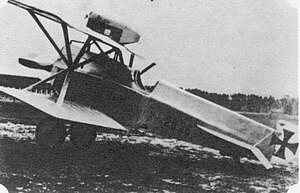The Hansa-Brandenburg D.I, also known as the KD (Kampf Doppeldecker) was a German fighter aircraft of World War I. Despite poor handling characteristics it was put into service by Austria-Hungary, where some aircraft served until the end of the war.
| D.I | |
|---|---|

| |
| Role | Fighter |
| Manufacturer | Hansa-Brandenburg |
| Designer | Ernst Heinkel |
| First flight | 1916 |
| Introduction | Autumn 1916 |
| Primary users | Austria-Hungary Austria |
| Number built | 122 |
| Variants | Hansa-Brandenburg KDW Phönix D.I |
Development and design
editErnst Heinkel chief designer of the Hansa und Brandenburgische Flugzeug-Werke developed the KD in 1916 to meet the requirements of the Austro-Hungarian Air Force (Kaiserliche und Königliche Luftfahrtruppen or K.u.K. Luftfahrtruppen). It was a single seat, single engined biplane, of wooden construction, with plywood fuselage skinning and fabric wing skins. The wings featured an unusual "Star-Strutter" arrangement of interplane struts, where four Vee struts joined in the centre of the wing bay to result in a "star" arrangement. The interplane struts themselves were steel tubes.[1]
The KD had a deep fuselage, which gave a poor forward view for the pilot and tended to blanket the small rudder, giving poor lateral stability and making recovery from spins extremely difficult.[2] Armament was a single Schwarzlose machine gun, which owing to difficulties in synchronising the Schwarzlose, was fitted in a fairing on the upper wing, firing over the propeller.[3]
Despite these handling problems, the aircraft was ordered by Austro-Hungary as the D.I. A total of 122 D.Is were built, with 50 built by Hansa-Brandenburg in Germany - powered by 110 kW (150 hp) Austro-Daimler engines - while a further 72 were built under license by Phönix in Vienna, powered by 138 kW (185 hp) Austro-Daimler engines. While it was intended that the D.I also be built by Ufag, none were delivered.[4] The KD also formed the basis for the Hansa-Brandenburg KDW floatplane fighter.
Operational history
editThe D.I entered service in autumn 1916. Its unusual arrangement of interplane bracing gave rise to the nickname "Spider",[5] while its poor handling gave rise to the less complementary nickname "the Coffin".[6] The D.I was the standard fighter aircraft of the Luftfahrtruppen until mid 1917, being used by several Austro-Hungarian air aces such as Godwin Brumowski and Frank Linke-Crawford.[5] Some Phönix built D.Is remained in use until the end of the war, being used briefly by the armed forces of The Republic of German Austria (Republik Deutschösterreich), where they were used to fight Yugoslav attacks on Klagenfurt in Carinthia.[1][7]
Operators
editSpecifications (D.I)
editData from The Complete Book of Fighters[1]
General characteristics
- Crew: 1
- Length: 6.35 m (20 ft 10 in)
- Wingspan: 8.5 m (27 ft 11 in)
- Height: 2.79 m (9 ft 2 in) [8]
- Wing area: 23.95 m2 (257.8 sq ft)
- Empty weight: 672 kg (1,482 lb)
- Gross weight: 920 kg (2,028 lb)
- Powerplant: 1 × Austro-Daimler 185hp 6-cylinder water-cooled in-line piston engine, 138 kW (185 hp)
- Propellers: 2-bladed wooden fixed-pitch propeller
Performance
- Maximum speed: 187 km/h (116 mph, 101 kn)
- Endurance: 2 hours 30 minutes
- Service ceiling: 5,000 m (16,000 ft) [8]
- Time to altitude: 1,000 m (3,300 ft) in 3 minutes.
Armament
- 1 × 8 mm (.315 in) Schwarzlose machine gun
See also
editRelated development
Aircraft of comparable role, configuration, and era
References
editNotes
edit- ^ a b c Green and Swanborough 1994, p.83.
- ^ Gray and Thetford 1962, p.64.
- ^ Williams and Gustin 2003, p.62
- ^ Silen, Art. IPMS Book Review: Albatros Productions, Ltd Windsock Datafile #118 Hansa Brandenburg D.1[permanent dead link] IPMS USA. Retrieved 2 March 2008
- ^ a b Hansa-Brandenburg D.I - The Aerodrome - Aces and Aircraft of World War I Retrieved 2 March 2008
- ^ Angelucci 1981, p.54.
- ^ Hooton 1994, p.25-26
- ^ a b Angelucci 1981, p. 43
Bibliography
edit- Angelucci, Enzo (ed.). World Encyclopedia of Military Aircraft. London: Jane's, 1981. ISBN 0-7106-0148-4.
- Gray, Peter and Thetford, Owen. German Aircraft of the First World War. London: Putnam, 1962.
- Green, William and Swanborough, Gordon. The Complete Book of Fighters. New York: Smithmark, 1994. ISBN 0-8317-3939-8.
- Hooton, E.R. Phoenix Triumphant: The Rise and Rise of the Luftwaffe.London: Arms & Armour Press, 1994. ISBN 1-85409-181-6.
- Meindl, Karl; Schroeder, Walter (1997). Brandenburg D.I. Great War Aircraft in Profile 2. Flying Machines Press. ISBN 1891268015.
- Williams, Anthony G. and Gustin, Emmanuel. Flying Guns World War I. Ramsbury, Wiltshire: Airlife, 2003. ISBN 1-84037-396-2.